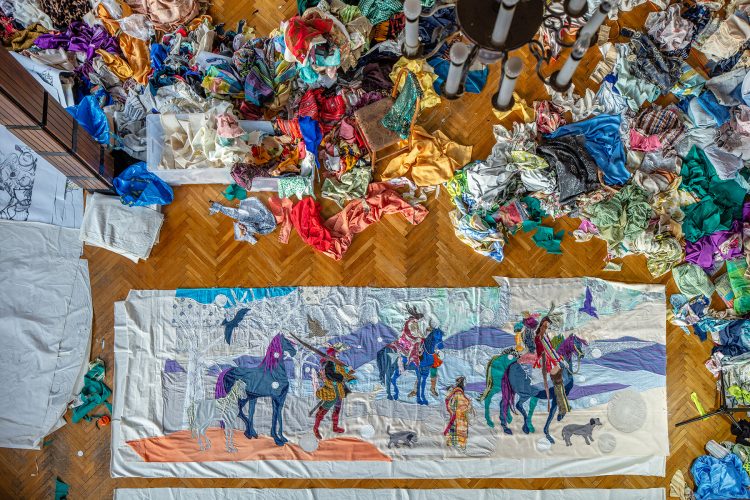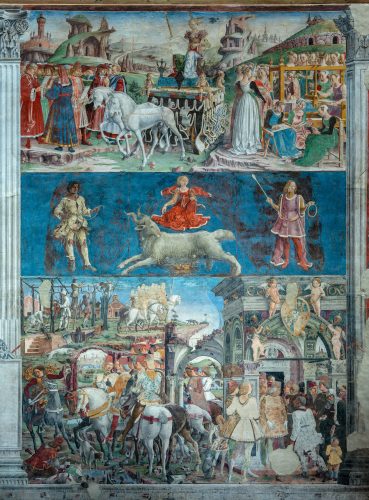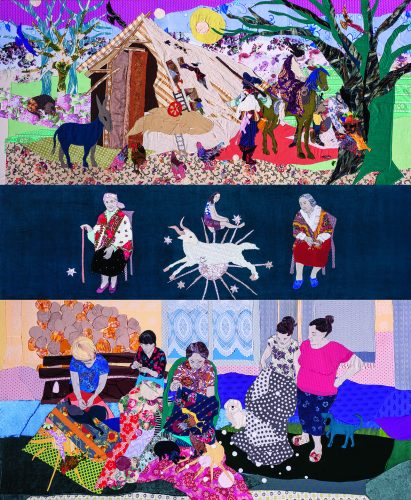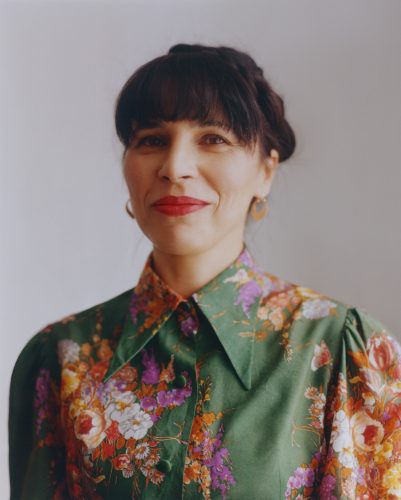Małgorzata Mirga-Tas: I Set Out to Re-Tell the Roma Story

Małgorzata Mirga-Tas: Re-Enchanting the World, work in progress. Photo: Daniel Rumiancew, Press materials of the Polish Pavilion.
Re-enchanting the World – a conversation with Małgorzata Mirga-Tas, the artist representing Poland at the 59th International Art Exhibition
Your monumental work in the Polish Pavilion refers to the famous “calendar” cycle of frescoes from the Renaissance Palazzo Schifanoia in Ferrara, Italy. How was the idea for this project born?
MMT: The project is an attempt to show the place of the Roma community in European art history. With the collaboration and support of curators Joanna Warsza and Wojciech Szymański, I was able to amalgamate and develop recurring themes in my work into this larger, more ambitious project, which has incorporated a great deal of time and effort. Re-enchanting the World combines my interest in reclaiming the Roma narrative, and documenting our history which has been marginalised in mainstream historiography, as well as revealing the quotidian life of contemporary Roma settlements. These three threads intertwine in the Polish Pavilion, following the narrative structure of the Hall of the Months in the Palazzo Schifanoia (Ferrara, Emilia-Romagna). The work consists of twelve pictures corresponding to the twelve months, divided into three horizontal bands. The upper band relates the story of the arrival of the Roma to Europe. The central band is the band of female strength and women’s power to enchant the world. The lower band depicts scenes from the life of Roma in Lesser Poland.

Palazzo Schifanoia, Hall of the Months, detail. Courtesy Schifanoia – Musei di Arte Antica – Ferrara. Photo: Daniel Rumiancew, Polish Pavilion press materials.
The upper band depicting the history of Roma wanderings in Europe refers to a series of prints by Jacques Callot, whose oeuvre you have taken as a departure-point before.
MMT: Indeed, Callot’s prints were the starting point for my exhibition last year, Out of Egypt, curated by Wojciech Szymański, serving as a visual example of how the act of the colonisation of the Roma was executed. Created in the 17th century, Callot’s etchings are riddled with anti-Roma prejudice and contributed to the Roma’s imprisonment in a conceptual ghetto – within imagery created by non-Roma for non-Roma on false premises. The purpose of my work was to reappropriate these Callot-appropriated images of Roma, which have had a profound impact on the way Roma are portrayed in Western culture. As an artist and as a Roma woman, I set out to re-tell the Roma story.
You call the central band the band of female strength, which intersects well with the context of the Feminist message of this year’s Biennale.
MMT: This central band is an archive of Roma history built from a woman’s perspective. The women’s perspective and wisdom are very important to me; I am inspired by the women in my family and my community. It happens that more women populate my paintings than men. I take ideas for images and scenes from my photo archive, and I continually catch myself gravitating towards scenes featuring women. There are simply more women in my photos, documenting family meetings or workshops I conduct in Roma settlements. You can spot, of course, an uncle from time to time. In the calendar, there is, for example, a funeral scene in which there are only men. However, these are the exceptions – although I do believe that men are also important and play an important role in our society. Nevertheless, as a woman, I recognise that women’s contributions often go unappreciated and unnoticed. Moreover, women coming from traditional communities like mine face more obstacles on their way to achieving their goals. I recognised this during a workshop on Roma heroines: while telling the children the story of Alfreda Markowska, a heroic Roma woman who saved many Roma and Jewish children from the Holocaust, I understood that the mothers who bring their children to the workshops are also heroes, fighting for a better future for their children. The central band refers to my ever-growing Herstories series, in which I present portraits of women who are important to me: heroines who have found their way into encyclopaedias, and those whose heroism still goes unnoticed. In Re-enchanting the World, I combine images of real women with symbols borrowed from tarot cards and astrology, which makes the women presented here even stronger and increases their power to re-enchant the world. It was not easy for me to include all the women who have inspired me into this band – twelve months is not enough, but I will continue to work with women’s stories in my future projects.

Małgorzata Mirga-Tas: Re-Enchanting the World, detail, 2022. Photo: Bartek Solik, Polish Pavilion press materials.
The lower band of the composition depicts scenes from the lives of the Roma of Lesser Poland. This is also a recurring theme in your works.
MMT: This was the band that was most difficult for me to create, because in choosing the scenes, I felt the weight of responsibility associated with deciding which narratives were the most important and needed to be included in the work. For instance, I thought about a pig slaughter scene, but I decided that I did not want to show violence, and so this did not make it into the series. What I do show here is card-playing in front of the house and a funeral; celebrating together is what makes our lives – it is the way I see the Roma people around me and would like to show them to others. My need to record scenes from the everyday lives of the Roma of Lesser Poland is part of a larger project to change the narrative about Roma by counterbalancing the prevalent stories of the mainstream discourse, which is created by non-Roma and presents a one-dimensional and often harmful picture of Roma. On the one hand, it is about assuming authorship and telling the Roma story from our own perspective. On the other hand, the calendar formula emphasises the inscription of human life into the biological cycle of nature. The lives of the heroes and heroines of these pictures revolve in a circle of recurring events. Thus, it offers the impression of something that has no end and is eternal.

Małgorzata Mirga-Tas. Photo: Ina Lekiewicz, Polish Pavilion press materials.
How do you understand the title, Re-enchanting the World?
MMT: The title is inspired by Silvia Federici’s book, Re-enchanting the World: Feminism and the Politics of the Commons (2018). I deploy re-enchanting as a non-violent process that is intended to change the world’s unfortunate events, undo the bad spell, and help to regain a sense of community and rebuild relationships with others. However, this will not happen with the touch of a magic wand. The formula of the calendar refers to the cyclical nature of our lives, and by documenting everyday life and small gestures, I try to show that everyone has the power to change the world. I am extremely pleased that, as a Roma, I was given the opportunity to create an exhibition for the Polish Pavilion. I see this as a chance to recover the narrative of Poland’s multi-culturalism, and I truly hope that the fact that I, as a Romani woman, won this competition for the exhibition in the Polish Pavilion will encourage other minority artists to apply for exhibitions in the national pavilions of the Biennale in the future.
Małgorzata Mirga-Tas is a Polish-Romani artist and activist. In her works, which comprise sculptures, paintings, spatial objects and large-format textiles, she addresses anti-Romani stereotypes and engages in building an affirmative iconography of Roma communities. She graduated from the Faculty of Sculpture at the Academy of Fine Arts in Krakow (2004). She has participated in many individual and group exhibitions, including the 11th Berlin Biennale (2020), the Art Encounters Biennial in Timişoara (Romania, 2019, 2021), 3rd Autostrada Biennale in Prizren (Kosovo, 2021), while her works have been shown at the Moravian Gallery in Brno (Czech Republic, 2017), the Center of Polish Sculpture in Orońsko (2020), Museum of Modern Art in Warsaw (2020), and Rautenstrauch-Joest-Museum in Cologne (Germany, 2021), among others. She lives and works in Czarna Góra, Poland.
Interview by Katarzyna Pabijanek for RomaMoMA.

[…] Next Blog Entry […]
[…] Previous Blog Entry […]